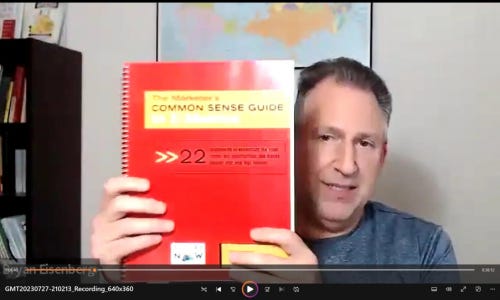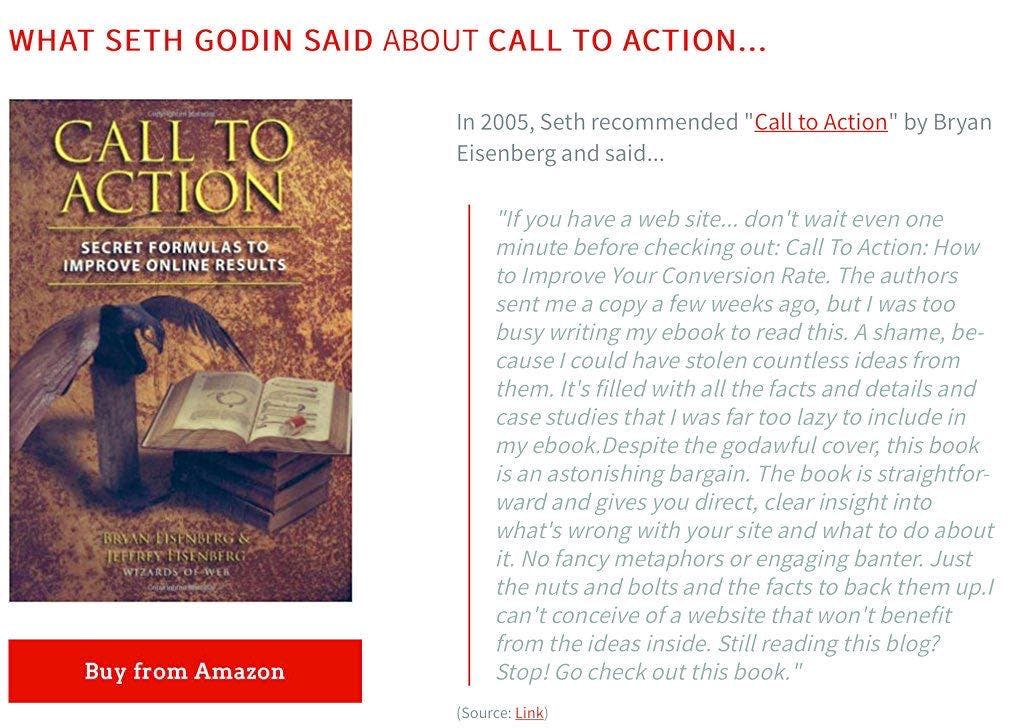🚀 ‘They who control the vocabulary, control the industry.’ My interview with Bryan Eisenberg
Are you familiar with the internet marketing terms “conversion rate optimization”, “bounce rate”, and “persuasion architecture”?
These are terms that us digital marketers take for granted.
Did these terms just appear out of thin air? Did they spontaneously roll of the lips – or keyboards – of digital marketers?
Of course not
Those terms were coined by two of the OGs of digital marketing: Bryan and Jeffrey Eisenberg.
In my continued research for my book, “StartupBook,” I interviewed the legendary Bryan Eisenberg on the power of books for designing and launching new categories.
I wanted to paste an excerpt from that eye-opening interview in today’s edition of the newsletter.
Bryan Eisenberg, together with his brother Jeffrey, have written dozens of books, including “Call to Action,” and “Waiting for Your Cat to Bark.” Together, those two books set the standard for the conversion rate optimization and persuasion architecture categories.
Interview with Bryan Eisenberg: The Genesis of “Call to Action”
In 2004 or 2005, we were preparing to write our next book. That’s when we penned the first edition of “Call to Action.”
The circumstances around this book were intriguing. We faced a challenge – [Webtrends] gave us three fewer weeks for the roadshow launch. So, we needed to adjust and streamline everything.
By that time, we had already made the term ‘conversion rate optimization’ widely known. It was gaining traction everywhere. We showcased examples like the cafe press checkout and demonstrated how we managed to reduce abandonment from 65 percent to just 15 percent through point of action assurances.
The Impact of “Call to Action”
Our publisher for [Call to Action] was Wizard of Ad’s Press, and even though it was self-published, it played a pivotal role in landing us a proper publisher.
Our strategy was to offer a free copy if two were bought, covering our basic costs. In the early days, when we started the business, I remember my friend Larry Chase, who was among the pioneers of online newsletters, handed me a copy of his book, which he called his $35 business card.
In those challenging times, Jeffrey and I were practically broke, and we could only afford something like a $2.50 business card. So, we printed a few thousand copies of our books.
The interesting development with ‘Call to Action’ was that by that point, our newsletter had gathered a substantial audience of around 30,000 to 40,000 subscribers.
It’s remarkable to recall the early days when we were coding email addresses manually, given that conventional email service providers like Aweber and MailChimp hadn’t taken off yet.
The Evolution of Email Marketing
In those days, emails were sent directly from our server that I personally coded. It was before the prevalence of platforms like Aweber and MailChimp. MailChimp, interestingly, became an early client of ours.
I remember the excitement of seeing names like Landsend.com and Orvis among our subscribers, indicating that people were paying attention. We took this momentum and sent copies of our book to various influential figures. Notably, we incorporated tips from these experts within the book’s pages.
Seth Godin’s Impact: Reaching the New York Times Best-Seller List
Seth Godin also received a copy. Soon after the book’s release, Seth penned a blog post urging people to overlook the seemingly unimpressive cover and purchase the book.
This endorsement propelled us to the New York Times and Wall Street Journal bestseller lists.
Although we weren’t close acquaintances, Seth’s support paved the way for conversations with publishers interested in our subsequent projects.
“Waiting for Your Cat to Bark”: The Next Chapter
Fast forward to the next year, and we had four publishers vying for our next title.
Our initial self-published success elevated our credibility, leading these publishers to believe we could accomplish even more.
However, at that stage, we had the title but hadn’t developed the story.
So, Jeffrey and I sequestered ourselves in a Long Island hotel room, brainstorming the narrative behind Pavlov, the dog, and the cat.
Pioneering “Persuasion Architecture”
Interestingly, it turns out that our work, ‘Waiting for Your Cat to Bark,’ became one of the top 10 best-selling books in its category during that period.
The journey from participating in discussions on the iSales and SEO lists to being invited to write for ClickZ and eventually speaking at SES events marked a significant trajectory for us. This progression played a significant role in propelling the industry’s growth.
The Power of Category Creation
Indeed, the prominence of ‘Waiting for Your Cat to Bark’ led to the popularization of the term ‘persuasion architecture,’ a concept that evolved as a separate category after the initial focus on conversion rate optimization.
This leads us to the heart of the matter – the concept of category creation. ‘Call to Action’ marked a significant turning point, a book that coincided with our previous content shared through our newsletter. That was a pivotal moment.
‘Call to Action’ was a major milestone. Our journey traces back to the influence of Roy Williams, the Wizard of Ads, our mentor. We took inspiration from his work to shape the design of ‘Call to Action.’ Roy imparted a vital lesson early on:
He who controls the vocabulary controls the industry.
– Roy Williams
Coining Terms, Key to Category Design
We introduced various terms to encapsulate the experiences people were encountering. For instance, the concept of ‘scent’ was vital. Dr. Ed Chi from Xerox PARC initially introduced it in a paper, but we took the term mainstream.
As we delved into the science underpinning conversion principles, we realized that the wider audience needed this knowledge. We examined and elucidated the idea of ‘scent’ with practical examples, which gained traction and is now used extensively.
Indeed, ‘scent’ pertains to message alignment. It’s about ensuring alignment from advertisements to landing pages and even across email sequences.








